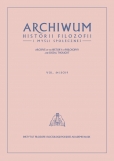Between Phenomenology and Semantics: Charles S. Peirce’s Conception of Categories Revisited
Between Phenomenology and Semantics: Charles S. Peirce’s Conception of Categories Revisited
Author(s): Anna MichalskaSubject(s): History of Philosophy, Philosophical Traditions
Published by: Instytut Filozofii i Socjologii Polskiej Akademii Nauk
Keywords: Charles S. Peirce;meaning;conceptualism;realism;phenomenological categories;
Summary/Abstract: Underlying the famous Peirce’s theory of signs is a much less frequently examined conception of phenomenological categories, first laid out in the article On A New List of Categories. Whereas the theory of signs, developed, modified, and refined over many years, is immensely complex, and thus open to many interpretations and applications, Peircean categorical system is relatively simple and straightforward, and, as such, provides a stable frame of reference for the discussions about intelligibility and meaning. My main aim in this paper is to show the utility of Peircean conception of categories in overcoming the difficulties associated with two approaches to the problem of meaning and reference, which, for the sake of argument, I will refer to as realism and conceptualism. To this end, I will explicate the difference between the said categories by means of a distinction between perceptual gestalts, emotional feelings (affects), and nonemotional feelings.
Journal: Archiwum Historii Filozofii i Myśli Społecznej
- Issue Year: 64/2019
- Issue No: 64
- Page Range: 113-128
- Page Count: 16
- Language: English

